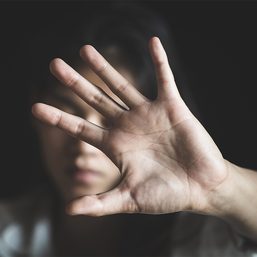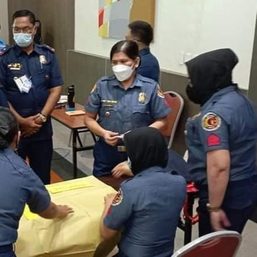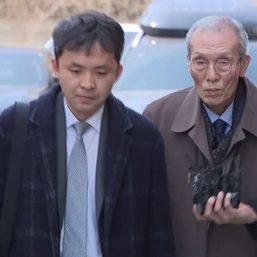SUMMARY
This is AI generated summarization, which may have errors. For context, always refer to the full article.
![[OPINION] Locusts: On entrapment, migration, and violent misogyny](https://www.rappler.com/tachyon/2021/09/ispeak-sq.jpg)
In a different life, I would have been an entomologist. I had studied insects with as much fervor as a child could have. On a family excursion, I caught about 50 grasshoppers, imprisoning them with blades of grass in a transparent canister with holes in the lid. The next morning, some of the critters looked earthier than green in color. Upon closer inspection, I was horrified to find dismembered grasshopper legs at the bottom of the vessel. When I released my captives, a few carcasses tumbled out last. The lifeless exoskeletons had been chewed through — eyes missing, thoraxes punctured, abdomens severed. It appeared as though, in this enclosure, some grasshoppers had turned to cannibalism.
I would later learn that in times of drought, certain varieties of grasshoppers overcrowd in small patches of viable grass. The population density triggers them to release a brain chemical, converting them from green solitary jumpers to the tan menaces that travel en masse as the dreadful clouds portending God’s wrath. This transformation has been described in terms of Dr. Jekyll and Mr. Hyde. The appearances and behaviors of desert locusts and their grasshopper counterparts were so divergent that, up until a century ago, scientists thought they were different species altogether.
There is no way for me to know whether a grasshopper-to-locust metamorphosis had taken place in my make-shift specimen jar from back when. The illustration of one form being good, the other evil, is valid only when you think of locusts in relation to humanity, but the allegory falls apart when one considers locusts in their own milieu, indifferent to people. The shift from solitary to swarming (“gregarious”) has actually been hypothesized to prevent their cannibalistic tendency. Banding together and migrating is a way to ensure the locusts’ survival. Thus, the state of entrapment I had created in the canister was so bad, it brought about the eat-or-be-eaten comportment that evolution had tried to mitigate.
Well into high school, I continued to study insects, mostly beetles. My parents bought me nature books; they helped me set up a terrarium for a more ethical means of scientific observation. My mother was supportive to a point — the point at which I told her I wanted to go the University of the Philippines-Los Baños (UPLB), home to the nation’s top entomology program.
“No,” my mother said. “That’s where Eileen Sarmenta went when she was killed.”
Eileen Sarmenta was a graduating agriculture student at UPLB. In June of 1993, six armed men, led by the local police deputy chief, stopped the passenger van in which she and her companion, Allan Gomez, occupied the front seats. The goons abducted Eileen and Allan. They delivered Eileen to the mayor, Antonio Sanchez, “as a gift,” and beat up Allan outside the rest house. Meanwhile, inside, Sanchez raped Eileen. His men then took Eileen and Allan into their vehicle once again. They shot Allan and left him on the side of the road. They took Eileen to a sugarcane field, where they gang-raped her. When they were done, they shot her in the face with a baby armalite, leaving her body out in the open.
The phonetic proximity between Eileen Sarmenta’s name and mine (Irene Sarmiento) was not lost on me — nor was it lost on my mother. It terrified her; she wanted to avoid any parallels between our lives. She suggested that I focus on moving to a rich nation through work in health care. She explained that there was too much corruption and extreme dearth in the country, turning ordinary citizens into monsters against whom I would have no defense. She was convinced that my disposition made me vulnerable to being devoured.
When I left the Philippines, I joined a migratory swarm of healthcare professionals, caregivers, nannies, domestic helpers, seafarers, hospitality personnel, laborers, engineers, construction workers, teachers, and many others, who, aside from their allotted luggage, carried invisible burdens — the financial futures of their families, the educations of the children they had to leave behind, debts to pay, the “hope fatigue” that perhaps only someone from a post-colonized frame of reference would deeply understand. Though I have no regrets over my career path, I still imagine a world in which fear didn’t weigh on the decisions I have made. In that world, maybe, Eileen is a successful agriculturalist; Kerima is alive — still writing poetry and balancing the scales of justice through activism; and thousands of trafficked Filipino women and children instead find opportunities to better their lives.
That world does not exist.
The violent misogyny sowed in my environment altered not just my behavior, but that of those around me — because violent misogyny reaps terror. I remember how many of us girls were not allowed to travel alone after dark; how we sat and held our purses with our arms crossed in front of our chests to avoid getting groped in public transit; how our male friends accompanied us to our parked cars or bus stops to help stave off harassment and assault. It’s strange to recount these instances now and realize how the specter of violent misogyny was pervasive, yet rarely discussed — as though the very mention of rape, or any harm to our bodies, could summon those demons.
When pandemic-related anti-Asian sentiment hit a dire crescendo in the US, and incidents of hate targeted mostly women, it stood to reason that even in the wealthier echelons of the planet, some people have yet to realize that women of color are sentient and intelligent. I went back and forth about whether I should make my voice a part of the discourse, fearing chauvinist backlash. It was around this time that I watched a short video in which Rappler founder, Maria Ressa, cited big data analysis to demonstrate how fascism and sexist abuse go hand in hand.
I thought, what is the point of finding “safety” if this fear is still in me?
This elicits a teenage memory, about which I am still ambivalent. I was in college, doing well in my courses, also learning the chaotic intricacies of the Manila transportation system. Feeling confident and empowered, I saw the city in a new light — as an exhilarating playground that promised fun, self-discovery, and young romance. After a trip to the museum, a girl friend and I headed toward the station stop. She was able to flag down her FX (a public-use SUV) before we got there. She boarded the vehicle, as I remained walking. The FX barely advanced when my friend opened the door and told me the driver would give me a ride to the stop for free. I got in, and after a short distance, disembarked at the terminal. I offered to pay the fare but the driver declined, saying I should use it for my next ride.
“I couldn’t just leave you on the side of the road by yourself,” he said. “This way, if I hear about a girl getting snatched there, at least I’ll know she wasn’t you.”
But I have never taken comfort in knowing that while I am safe, scores of women and girls are not. They are somewhere, far away, trapped in a cannibalistic enclosure. – Rappler.com
Irene Carolina Sarmiento is the author of two illustrated children’s books, Spinning and Tabon Girl, both published by Anvil. Her stories have won awards from The Palanca Memorial Foundation, Philippines Free Press, Philippine Graphic/Fiction Awards, and Stories to Change the World. She is an occupational therapist with a master’s degree in Applied Cognition and Neuroscience.
Add a comment
How does this make you feel?
![[Dash of SAS] The anguish of the migrant mother](https://www.rappler.com/tachyon/2021/08/migrant-mothers-September-11-2021.jpg?fit=449%2C449)















![[OPINION] The myth of the individual narrative in the struggle against sexual violence](https://www.rappler.com/tachyon/2024/02/ispeak-struggle-for-safe-spaces-feb-7-2024.jpg?resize=257%2C257&crop=274px%2C0px%2C720px%2C720px)

![[OPINION] Data is crucial to preventing gender-based violence](https://www.rappler.com/tachyon/2023/11/TL-ogbv-nov-28-2023.jpg?resize=257%2C257&crop=271px%2C0px%2C720px%2C720px)

There are no comments yet. Add your comment to start the conversation.